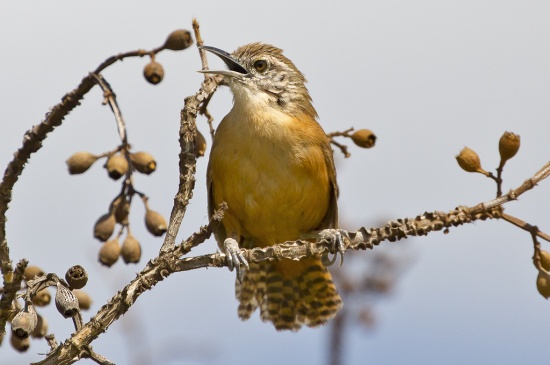- Cantorchilus leucotis
Thryothorus leucotis
Identification
14–14·5 cm (5½-5¾ in)
- Buff breast
- Rufous belly
- Black barred wings and tail
- Sides of head streaked black and white
- Narrow white supercilium
Similar Species
Distribution
Central and South America
Central America: found only in Panama
South America: Colombia, Venezuela, Guyana, Suriname, French Guiana, Ecuador, Peru, Bolivia, Brazil and Paraguay
Taxonomy
Was formerly placed in genus Thryothorus like all other species of the genus Cantorchilus.
Subspecies
There are 11 subspecies[1]:
- C. l. galbraithii: Eastern Panama and north-western Colombia (northern Chocó and northern Antioquia)
- C. l. conditus: Pearl Islands and Coiba Island (Gulf of Panama)
- C. l. leucotis: Northern Colombia (western slope of Santa Marta Mountains to Magdalena Valley)
- C. l. collinus: Northern Colombia (northern Guajira Peninsula in Serranía de Macuira)
- C. l. venezuelanus: Northern tropical Colombia and north-western Venezuela
- C. l. zuliensis: Eastern Colombia (Norte de Santander) to western Venezuela
- C. l. peruanus: South-eastern Colombia to eastern Ecuador, eastern Peru, northern Bolivia and western Amazonian Brazil
- C. l. bogotensis: Llanos of eastern Colombia to central Venezuela
- C. l. hypoleucus: Llanos of north central Venezuela
- C. l. albipectus: North-eastern Venezuela to the Guianas, north-eastern Brazil and northern Mato Grosso
- C. l. rufiventris: Eastern Brazil (southern Maranhão to Piauí, Goiás, Minas Gerais and São Paulo)
Habitat
Wide variety of forest, woodland, edges, and clearings to less than 1000 m asl.; often near water.
Behaviour
Has reputation for being retiring but curious. Usually as pairs or small flocks.
Most frequent in vine tangles up to sub-canopy, sometimes on the ground.
Diet
Their main diet consists of invertebrates, such as beetles, bugs and flies.
References
- Clements, J. F., T. S. Schulenberg, M. J. Iliff, D. Roberson, T. A. Fredericks, B. L. Sullivan, and C. L. Wood. 2018. The eBird/Clements checklist of birds of the world: v2018. Downloaded from http://www.birds.cornell.edu/clementschecklist/download/
- Avibase
- Restall et al. 2006. Birds of Northern South America. Yale University Press. ISBN 9780300124156
- Arthur Grosset
Recommended Citation
- BirdForum Opus contributors. (2024) Buff-breasted Wren. In: BirdForum, the forum for wild birds and birding. Retrieved 26 April 2024 from https://www.birdforum.net/opus/Buff-breasted_Wren
External Links
GSearch checked for 2020 platform.




